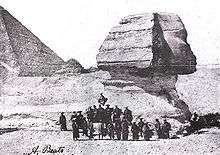Antonio Beato
| Antonio Beato | |
|---|---|
| Born | after 1832 |
| Died | 1906 |
| Nationality | British, Italian |
| Other names | Antoine Beato |
| Occupation | Photographer |
| Known for | His genre works, portraits, views of the architecture and landscapes of Egypt and the other locations in the Mediterranean region |
| Relatives | Felice Beato (brother) |

Antonio Beato (after 1832 – 1906), also known as Antoine Beato, was a British and Italian photographer. He is noted for his genre works, portraits, views of the architecture and landscapes of Egypt and the other locations in the Mediterranean region. He was the younger brother of photographer Felice Beato (1832–1909), with whom he sometimes worked.
Life and work
Little is known of Antonio Beato's origins but he was probably born in Venetian territory after 1832, and later became a naturalised British citizen. His brother, at least, was born in Venice, but the family may have moved to Corfu, which had been a Venetian possession until 1814 when it was acquired by Britain.
Because of the existence of a number of photographs signed "Felice Antonio Beato" and "Felice A. Beato", it was long assumed that there was one photographer who somehow managed to photograph at the same time in places as distant as Egypt and Japan. But in 1983 it was shown by Italo Zannier (Bennett 1996, 38) that "Felice Antonio Beato" represented two brothers, Felice Beato and Antonio Beato, who sometimes worked together, sharing a signature. The confusion arising from the signatures continues to cause problems in identifying which of the two photographers was the creator of a given image.
Antonio often used the French version of his given name, going by Antoine Beato. It is presumed that he did so because he mainly worked in Egypt, which had a large French-speaking population.
In 1853 or 1854 Antonio's brother and James Robertson formed a photographic partnership called "Robertson & Beato". Antonio joined them on photographic expeditions to Malta in 1854 or 1856 and to Greece and Jerusalem in 1857. A number of the firm's photographs produced in the 1850s are signed "Robertson, Beato and Co." and it is believed that the "and Co." refers to Antonio.
In late 1854 or early 1855 James Robertson married the Beato brothers' sister, Leonilda Maria Matilda Beato. They had three daughters, Catherine Grace (born in 1856), Edith Marcon Vergence (born in 1859) and Helen Beatruc (born in 1861).

In July 1858 Antonio joined Felice in Calcutta. Felice had been in India since the beginning of the year photographing the aftermath of the Indian Rebellion of 1857. Antonio also photographed in India until December 1859 when he left Calcutta, probably for health reasons, and headed for Malta by way of Suez.
Antonio Beato went to Cairo in 1860 where he spent two years before moving to Luxor where he opened a photographic studio in 1862 and began producing tourist images of the people and architectural sites of the area. In the late 1860s, Beato was in partnership with Hippolyte Arnoux.
In 1864, at a time when his brother Felice was living and photographing in Japan, Antonio photographed members of Ikeda Nagaoki's Japanese mission who were visiting Egypt on their way to France.
Antonio Beato died in Luxor in 1906. His widow published a notice of his death while offering a house and equipment for sale.
A Freemason, he was member af a masonic Lodge in Beirut and later joined the Bulwer Lodge Nr. 1068 in Cairo and was co-petitioner for the foundation of the Grecia Lodge Nr. 1105 in the Egyptian capital.[1]
References
- ↑ Dorothe Sommer, Freemasonry in the Ottoman Empire, I. B. Tauris, London - New-York, 2015, p. 117-118.
- Antonio e Felice Beato (Venice: Ikona Photo Gallery, 1983).
- Bennett, Terry. Early Japanese Images (Rutland, Vermont: Charles E. Tuttle Company, 1996), 126, 143, pl. 118.
- Bennett, Terry. History of Photography in China, 1842–1860 (London: Bernard Quaritch Ltd., 2009), 141, 241.
- Borcoman, James. Magicians of Light (Ottawa: The National Gallery of Canada, 1993), 82, 267.
- Canadian Centre for Architecture; Collections Online, s.v. "Beato, Antonio". Accessed 14 April 2011.
- Clark, John. Japanese Exchanges in Art, 1850s to 1930s with Britain, continental Europe, and the USA: Papers and Research Materials (Sydney: Power Publications, 2001), 89–92, 115.
- George Eastman House Catalog, s.v. "Beato, Antonio". Accessed 27 September 2006.
- McGee, John. Transparent Windows: Politics of Landscape, Metropolis, Japan Today, 21 February 2003 No. 465. Accessed 27 September 2006.
- The New York Public Library, s.v. "Beato, Antonio". Accessed 27 September 2006.
- The New York Public Library, "Louxor : Temple de Amenhophis, corte est". Accessed 27 September 2006.
- Osman, Colin. "Antonio Beato: Photographs of the Nile" History of Photography, vol. 14, no. 2 (April–June 1990), 101–110.
- Oztuncay, Bahattin. James Robertson: Pioneer Photography in the Ottoman Empire (Istanbul: Eran, 1992), 13, 25–26, 32.
- Perez, Nissan N. Focus East: Early Photography in the Near East, 1839–1885 (New York: Harry N. Abrams, Inc. 1988), 131, 127.
- Rosenblum, Naomi. A World History of Photography (New York: Abbeville Press, 1984), 121–122.
- Union List of Artists Names, s.v. "Beato, Antonio". Accessed 3 April 2006.
- Zannier, Italo. Verso oriente: Fotografie di Antonio e Felice Beato (Florence: Alinari, 1986).
External links
| Wikimedia Commons has media related to Antonio Beato. |